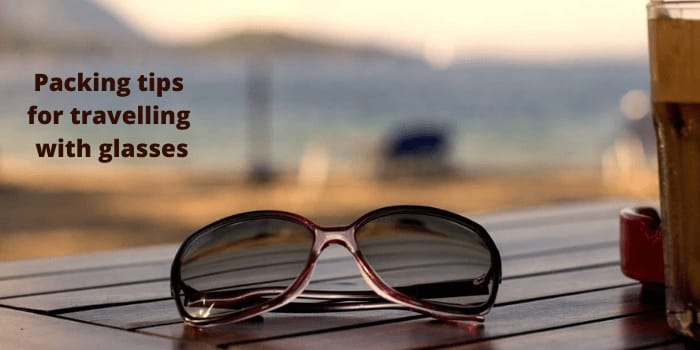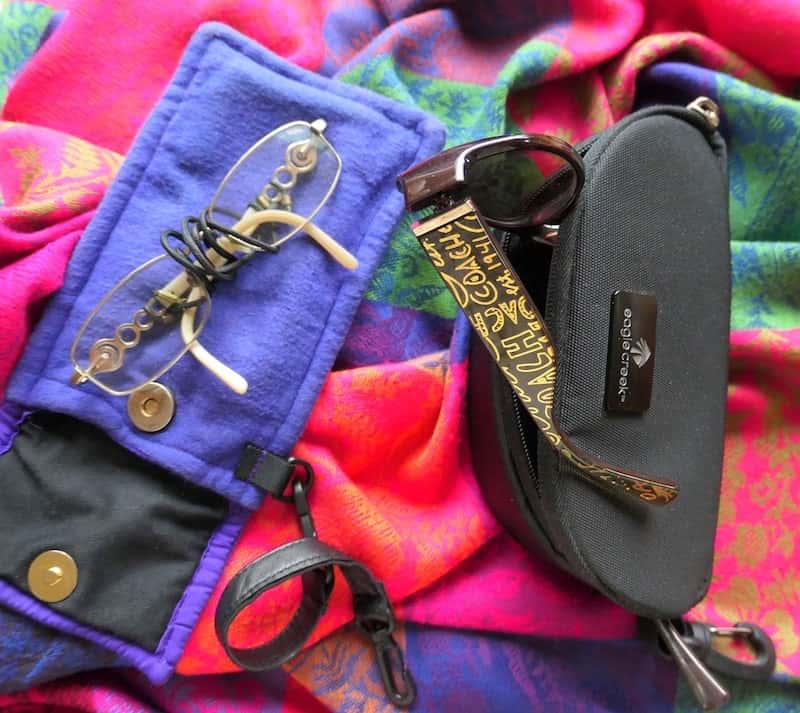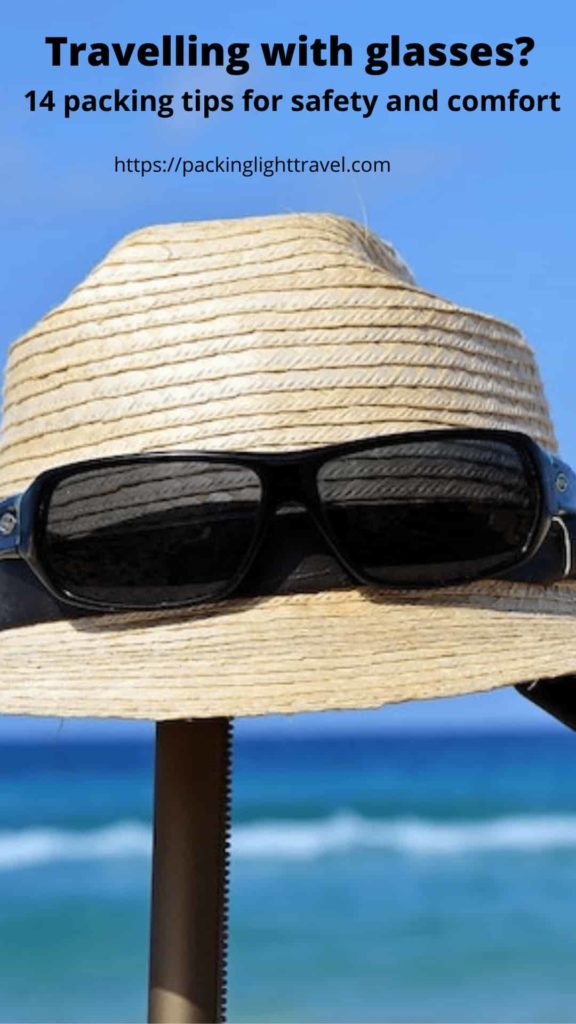Updated August 2, 2022
If glasses are an essential part of your everyday life, they will be just as necessary, if not more so, while travelling. If you’re relying on eyewear to read signs or a menu, find your way in an unfamiliar environment, protect your eyes from dangerous ultraviolet (UV) rays, and soak up the sights you’ve travelled so far to see, the following packing tips for travelling with glasses and sunglasses may be useful.
Table of Contents
- Packing tips for travelling with glasses and sunglasses
- 1. Bring an extra pair
- 2. Take your glasses for a pre-trip tune-up
- 3. Will Transition™ lenses be adequate?
- 4. Sunglasses could be essential
- 5. Pack primary eyeglasses in your personal item
- 6. Choose a suitable case that can’t be easily misplaced
- 7. Bring a copy of your prescription
- 8. Attach a neck strap or tracker to your glasses
- 9. Consider packing an eyeglass repair kit
- 10. In-ear or over-ear headphones?
- 11. Get a good quality mask that doesn’t fog your glasses
- 12. Do you need anti-fog spray, wipes, or cloth?
- 13. Pack a hat that shades your eyes
- 14. Plan to keep your glasses clean
Packing tips for travelling with glasses and sunglasses
1. Bring an extra pair
Having the extra pair means that losing or damaging your glasses won’t have an adverse effect on your travel plans. Picture yourself on a trip of a lifetime to Antarctica or Africa to observe the wildlife with nary an optician in sight. Suddenly, that back-up pair of glasses becomes the most important item you’ve packed.
An extra pair might have been obtained at a significant discount when the last prescription was filled. Or it may be an old pair that are still functional or a cheap pair of prescription eyeglasses from an online service. Another option is to carry an emergency travel-friendly back-up. ThinOptics offer a variety of options. Mine take up a tiny space in their permanent place in a pocket of my crossbody bag. They weigh just 4g / 0.2 oz or 18 g/ 0.6 oz in their slim case. The ultralight case has an adhesive strip allowing it (with the glasses inside) to be attached to a cell phone.
2. Take your glasses for a pre-trip tune-up
I live near a satellite clinic staffed by optometrists and opticians who make the 45-minute drive from the main clinic to provide service to our rural community. Could I have a prescription filled at Costco, a three-hour drive away, at a lower price? Probably. Or an online service to have a prescription filled at a fraction of the price of what I pay locally? Undoubtedly.
What I’ve discovered is that when a screw pops out, or a nose guard breaks off, I drop into the local eyewear clinic to have my glasses fixed at no charge. In addition, it’s been many years since I’ve had to pay to replace my glasses because the clinic honoured the original warranty when a replacement was needed. I figure I’m ahead on cost and convenience, and supporting jobs in my region of the province is beneficial.
All this to say, take your glasses to your eyewear clinic to ask for a tune-up before leaving on a trip. Ask for the frames to be checked, screws to be tightened, and to receive a clean bill of health for your eyewear. If your clinic is anything like mine, the service will be provided at no charge.
3. Will Transition™ lenses be adequate?
An advantage of Transition™ photochromic lenses is that they combine the benefits of regular glasses and sunglasses in one pair. Transition™ lenses change colour in response to UV light from the sun and offer 100% protection from UV rays. They’re convenient when moving between outdoors and indoors. While indoors (or at night), the lenses are clear, but they gradually darken when outdoors during daylight and lighten again when returning indoors.
4. Sunglasses could be essential
Sunglasses are critical for destinations that involve beaches and snow. Eighty per cent or more of the sun’s rays reflect off water, snow, and sand, subjecting skin and eyes to extra exposure. Also, UV intensity increases with altitude, so eyes need to be well protected while skiing and snowboarding.
Part of a trip often overlooked is during transit. Windshields, windows, and glass don’t block UVA (ultraviolet A rays) so keep those sunglasses handy.
Clip-on shades worn over prescription glasses might appeal to travellers looking for a reasonably priced product that takes less space than a separate pair of sunglasses. I tried this option for a trip to Australia with mixed results. For me, there were too many disadvantages for them to be a permanent solution:
- The smaller frames of my prescription glasses with the clip-on shades offered less coverage and protection than sunglasses.
- I worried about scratching my prescription lenses each time I attached and removed the clip-on frames (and my hands needed to be clean and dry).
- It felt more finicky and inconvenient than reaching for a pair of sunglasses and slipping my eyeglasses in the empty case.
The advantage of sunglasses over clip-on shades or glasses with Transition™ lenses is that sunglass frames tend to be larger, offering greater coverage. Also, the lenses come in various shades of darkness. However, the level of UV protection (look for 100%) is more important than the shade of the lens.
 Photo credit: jessiebuss, Pixabay
Photo credit: jessiebuss, Pixabay
5. Pack primary eyeglasses in your personal item
Packing glasses in an in-flight bag stowed under the seat in front means they’re within easy reach during the flight. With glasses packed in your carry-on bag(s), you can be assured they’ll arrive with you at the destination. It’s also unlikely they’ll be damaged. It’s never a good idea to pack essential eyeglasses in checked luggage. You have no control over how it will be handled (or where it will end up) when it’s no longer in your possession.
Also, during the flight, skip the seatback pocket for temporarily stowing your glasses. It’s not a hygienic location (stories of dirty diapers and used tissues are real). Besides, it’s so easy to leave something behind when it’s not safely carried in a bag or secure pocket.
6. Choose a suitable case that can’t be easily misplaced
A hard case, or a well-padded soft case, will help protect glasses from damage. Get into the habit of stowing glasses in the case when you’re not wearing them.
One that can be tethered to an anchor point in a day bag will help guard against loss and prevent the case from roaming free in a bag where it is more challenging to locate. When engaged in outdoor activities, a case attached to a belt loop or an external attachment point on a bag will put the case within easy reach.
7. Bring a copy of your prescription
Having a copy of your most recent prescription may fast track your ability to get a new pair of glasses in your time of need. If you have annual eye exams, mention that you’d like a copy of the prescription to take with you on your travels in the event of an emergency. Pack a physical copy or use a scanning app to save a digital copy to your phone or Dropbox account. It may save you the expense of an eye exam (and the difficulty of doing so with an unfamiliar alphabet).
8. Attach a neck strap or tracker to your glasses
Avoid carrying glasses in your hand. It’s too easy to put them down somewhere and forget where it was. It’s a recipe for leaving them behind. Also, resist the urge to balance them on your head, hang them on a shirt collar, or place them in an open pocket. I’m guilty of adopting all these habits that have resulted in temporarily losing my glasses.
(i) Neck strap
A neck strap helps guard against loss or damage while enabling a wearer to go hands-free.If you frequently take off your glasses, a neck strap will ensure that they stay around your neck. That’s my reality, and I take comfort in that they hang within easy reach to slip them back on if I need to read a menu or pamphlet or use an app on my phone.
A nylon-braided cord strap with non-slip attachments is durable and easily cleaned with a quick wash and dry. Mine has lasted for years. There are packs with cords of various colours to switch up with different outfits.
A robust retainer is essential for sunglasses when engaged in physical activities with a higher chance of damage or loss. For sunglasses with thicker arms than those of my reading glasses, I use a Croakies terra cord max retainer.
(ii) Tracker
While not widely available, a small tracker attached to the frame of your glasses can help locate a lost or temporarily misplaced pair. Currently, Foxsmart produces a black or transparent tracker measuring 2.69 x 0.48 cm (1.06 x 0.19 in) that can be paired with an app for Android and Apple devices. Orbit produces a tracker that works with Apple’s Find My app.
9. Consider packing an eyeglass repair kit
Depending on the length of your trip and how critical your eyeglasses are to your everyday existence, a basic, lightweight repair kit comprising a small screwdriver and a few screws may be a worthy investment. For digital nomads who work abroad and travel for months or years at a time, it’s worth investigating. For my type of travel (a month or so for each trip), my duct tape fob is enough to fashion most emergency repairs until I can locate an optician or technician to get the job done right. That was my experience in Australia; the technician fixed my glasses within minutes and refused to accept any payment.
10. In-ear or over-ear headphones?
Do you use headphones when you travel? If so, in-ear headphones may be more compatible with eyeglasses if you need to choose a podcast or audiobook, watch a movie, or access a playlist. It’s worth checking the compatibility and comfort factor of headphones before making a purchasing or packing decision.
11. Get a good quality mask that doesn’t fog your glasses
Until I invested in a quality mask with a design that ensures a tight seal, fogged glasses were a major irritant. The breathable fabric, flexible reinforced nose wire, and adjustable sliders on the ear straps of my Sonomask Pro all contribute to a comfortable fit and fogless eyewear.
If your glasses fog up, it’s probably because your mask doesn’t fit properly. Masks with an adjustable nose clip (and adjustable ear straps) help create a tighter fit that should keep puffs of warm breath from drifting upwards and fogging your glasses.
Some people use skin-safe surgical or athletic tape across the top edge of the mask to achieve a tighter seal.
12. Do you need anti-fog spray, wipes, or cloth?
Household products such as shaving cream and toothpaste might offer a temporary anti-fog fix, but the lens coatings may suffer damage over time. A better solution is to look for a product specifically designed to safely use with eyeglasses, binoculars, ski masks, camera lenses, and snorkel masks, one that keeps them fog-free for an extended period.
Commercially produced anti-fog sprays and wipes coat the surface with a see-through film that prevents fog from forming. Ensure the product is specifically designed for eyewear and claims that the ingredients won’t harm the protective coating on lenses.
Wipes tend to be prepackaged for single use. Another option is to purchase a specially coated reusable microfibre cloth.
13. Pack a hat that shades your eyes
See: What is the best packable sun hat for packing light travellers?
A hat with a brim offers an extra layer of protection from the sun. One with a brim of at least 3 in / 7.6 cm of tightly-woven fabric (with no holes) can block as much as half of all UV rays from the wearer’s eyes and eyelids.
 Photo credit: het terski, Pixabay
Photo credit: het terski, Pixabay
14. Plan to keep your glasses clean
Storing your glasses in their respective cases when you’re not wearing them will reduce exposure to dust and grime.
Before cleaning your glasses, wash and dry your hands so they’re free of dirt, grime, lotion, and anything else that could transfer to your lenses.
Rinse your glasses under a gentle stream of cool or lukewarm tap water to remove dust and other debris that can scratch lenses during cleaning.
The best way to clean lenses is to use a specially formulated cleaning solution and a microfibre cloth. Spray both sides of each lens. Then, gently rub the lenses in a circular motion to wipe the cleaning solution across the surface. Keep gently wiping until the solution has evaporated. If you’re looking for a recommendation, I like Green Oak Professional Lens Cleaner. It doesn’t leave any streaks and decants easily into a travel-friendly spray bottle.
Is a mild dish soap safe to clean glasses? Some suggest it is, others that it’s not. As soap has the potential to damage the lens coating over time, it’s wise to avoid using any cleaning agent designed to ‘remove grime’ as a regular lens cleaner.
Carry a microfibre lens cloth in each case, so it’s always handy. Some outerwear comes with one attached to a pocket. Fashion a DIY version by sewing a lightweight cord or leash to a lens cloth to attach to a pocket’s inside seam.
Resist the urge to give your glasses a quick wipe with your shirt. The fibres in the fabric will scratch the lens over time. Also, avoid tissues, paper towels, or a dishtowel.
If you found this post helpful, please share it by selecting one or more social media buttons. Do you travel with glasses or sunglasses and have anything to add? If so, please share your thoughts in the comments. Thank you.
Care to pin it for later?
Photo credits: sky tom, Pixabay (PIN image) and ana j, Pixabay (Feature image)
The Amazon links on this post are affiliate links. This means that if you click on one and buy something, you don’t pay more but this site earns a small commission that helps with the costs of maintaining the site. Thank you for your support.









Trackbacks/Pingbacks